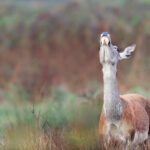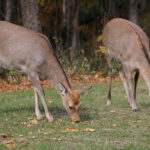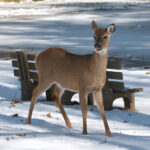Most hunters and deer enthusiasts in western North America are exposed to many wonderful species of deer. Two of these species are often confused with one another because they share many similarities; the mule and blacktail deer.
Luckily the question of if you are dealing with a blacktail deer vs mule deer can be solved with the identification of several interesting differences.
Table of Contents
- Blacktail Deer vs Mule Deer
- Habitat
- Diet
- Physical Characteristics
- Size
- Antlers
- Fur and Color
- Social Behavior
- Similarities of Blacktail Deer vs Mule Deer
- Conclusion
Blacktail Deer vs Mule Deer
The blacktail deer is a subspecies of the mule deer. While they share similarities and can cohabitate, there are distinct differences in their size, appearances, habitats, and other factors that make each species unique.
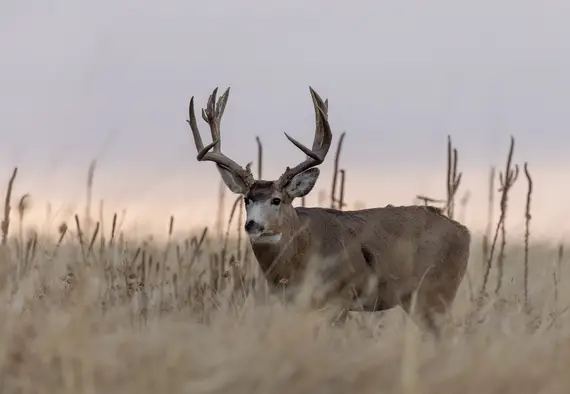
The similarities make sense as they had common ancestors in western North America when ice sheets covered the land approximately 15,000 years ago.
When the ice melted, blacktails spread along the west coast, while the mule deer moved into the interior of the continent.
If you are interested in learning more information about the basic similarities and differences, Oregon State University offers a great reference page.
Habitat
The ranges of each species have been well documented. Depending on the location, the climate, and the time of the year, it should be fairly easy to tell the difference between the two.
Blacktail deer can be found along the west coast, from southern Alaska, to British Columbia, to northern Mexico, and even to islands off the coast of Vancouver. Blacktails prefer mild winters and humid environments.
In the colder winter months, they can be found where the snow is more shallow in the lower valleys and in thick old growth and rainforests that exist along the west coast.
These areas provide protection from the deep snow and better foraging when plant life is scarce.
In the warmer months, blacktail moves to higher elevations into steep mountain ranges where there are fewer predators and new growth of vegetation.
Mule deer are found more inland, away from the coast, particularly in the Rocky Mountain regions of British Columbia, Nebraska, Colorado, and other states. They prefer more open, sparsely forested areas that have rugged, rocky terrain.
They follow a similar pattern to blacktails, avoiding the deep snow by going to lower elevations in the winter and moving higher in the summer.
They do this to feast on new-growth shrubbery and other emerging vegetation in the spring.
Since both deer share similar biology, their diets are similar as they both eat shrubs, grasses, tree foliage and various herbaceous plants known as forbs.
Diet
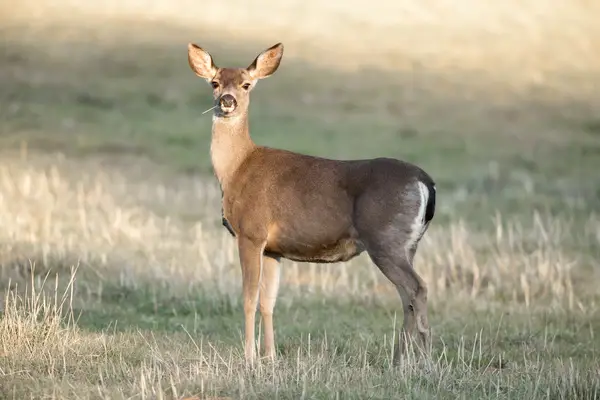
But as their habitats and ranges are rather separated, each has a different diet unique to their areas. Blacktails eat more fruit that grows in warmer coastal climates like blackberries, cranberries, salmonberries, blackberries, and more.
Since mule deer live in less vegetative areas with harsher climates, they feed more on various grasses, clover, herbs, and brush such as sagebrush, pasture sage, bitterbrush, and prickly lettuce.
See also: Coues Deer vs Whitetail Deer: Differences & Comparison.
Physical Characteristics
There are several minor but noticeable differences when trying to tell mule deer and blacktail deer apart. Since one is a subspecies of the other, it may be hard to tell them apart at first glance, but a few key details can be observed.
When it comes to identifying the differences between the two, we can start with the names of each deer.
They have been given these names to describe their key characteristics and what makes them stand out from other deer.
The mule deer was given its name because of its elongated, large ears that are reminiscent of a mule’s ears.
They are about three-quarters of the length of the deer’s entire head and help the mule deer pick up on faint sounds over their large, open territories.
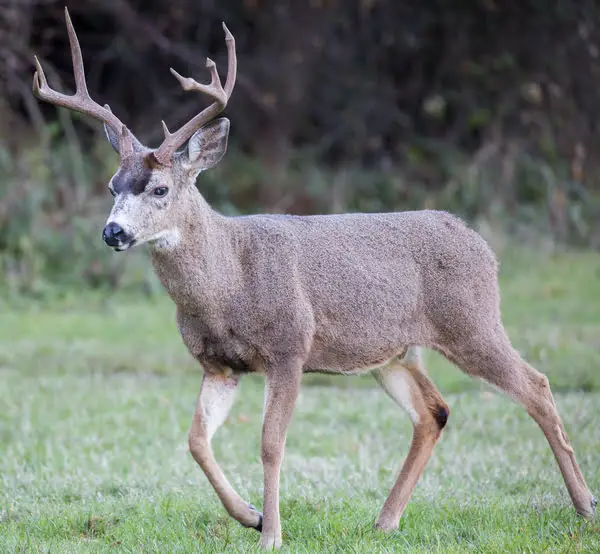
While blacktails have similar ears, they are noticeably smaller than the mule’s, which is a great identification trick!
Blacktails, on the other hand, have all black tails. This is actually a pretty unique characteristic as most other deer in North America have white tails, hence the whitetail deer, while mule deers have mostly whitetails with a small black tip.
Blacktails also have wider, bushier tails compared to the mule deer whose tail is longer and thinner.
This is another quick way to identify one from the other. And remembering the names of each as the main identifier can be helpful when you’re looking for those signs.
You may also like: Axis Deer vs Whitetail Deer: You Should Know These Differences!
Size
Mule deer are the larger of the two species, having a larger frame, being heavier, and having longer antlers.
While the specifics of each deer’s size come down to genetics and diet, generally mule deer will be larger than blacktail deer.
Adult buck mule deers can range from 4 to 7 feet long and can stand up to 4 feet tall before their antlers. They can also weigh between 150 to 250 pounds on average, while the females weigh between 110 to 165 pounds on average.
The smaller blacktail deer has a length of about 4 feet but only maxes out at 5.5 feet while standing a few inches shorter than the mule deer at about 3.7 feet. Fully grown does weigh as little as 80 pounds while bucks weigh 160 pounds on average.
As evident from the height and weight differences, mule deer have a more muscular look with broader shoulders, a thicker neck, and a larger head to support its larger antlers.
Antlers
Typically, the stock of the antlers on a mule deer buck is about 50% thicker than those on a black-tail deer.
Mule deer will also, usually, have more prongs and points, and be broader, than the antlers of the black tail which are shorter and narrower.
Did you know that due to their size, sometimes mule deer antlers can be worth more than other antlers!
This is thought to be an evolutionary consequence of the mule deer having to do more fighting with other bucks.
Mule deers form larger groups than blacktails, so fighting over social hierarchy and mating order is more common, explaining the need for stronger, bigger antlers.
Fur and Color
Besides the color of each deer’s tail, there are a few other differences in their fur and coloration that help tell the difference between one and the other. The most obvious one is the fur on the rump of each deer.
Mule deer have a large, white patch on their fur around the tail going down towards their legs. The blacktail deer doesn’t have this feature, with the fur on its rump being the same color as the rest of its body.
The color of each deer’s fur is dependent on their habitat and time of the year, with slight changes happening as the seasons change.
The fur of the mule deer is brown with a reddish tone in the summer months. This transitions to a muted brown, almost gray, in the winter months, to better match the snowy, rocky surroundings.
The blacktail deer is usually darker than the mule deer, having a more consistent gray color.
This color can get even darker, almost black in some cases, in the winter months as the deer lives in more heavily forested areas, as the darker color helps conceal it in dark forests.
Their facial fur follows this same pattern as well, with mule deer having brighter facial features with more white fur. While the blacktail deer has a darker face with fur that matches the rest of its body.
Social Behavior
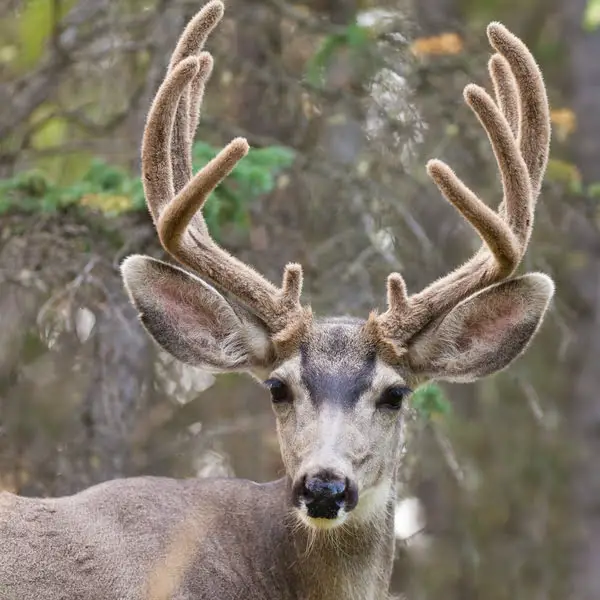
Throughout most of the year, both blacktails and mule deer like to travel alone or in very small groups.
In mating season and other times of the year, however, mule deer appear to form larger herds of females who all share the same mother and males from different families.
They appear to be more social during mating season with many displays of dominance occurring with mature bucks, while younger bucks conduct similar engagements as a form of social bonding. This is not a common phenomenon for blacktail deer.
Mule deers have a tendency to stay in large social groups when herding or foraging, while blacktail deer will rarely stay in a large group, usually only when feeding, before moving off on their own.
Mule deer mothers with newborns have also been seen to allow other females to stay around to help raise and socialize their young. Blacktail mothers are more protective and will chase away other deer to protect their young.
Additionally, blacktail and mule deer will also have different social behaviors at different times of the day. Like any other deer species, nocturnal behavior may increase due to hunting pressure, predators and habitat encroachment.
Similarities of Blacktail Deer vs Mule Deer
When tracking deer, it could be difficult to know which of the two are nearby without seeing them for yourself.
Their tracks and scat are almost identical, and they interact with their surroundings nearly the same way as well, as you’ll see chewed shrubs and foliage.
Tracks you find in the snow or wet ground can be similar, as both species do what’s known as ‘pronking’, where they leap and land with all four legs at the same time. This will be evident in the tracks they leave.
They both have similar life spans, living for about 10 or 11 years in the wild and can live up to 20 years in captivity.
Their ranges occasionally intercept, where you would be able to find both species in the same area. Mule and blacktail deer have even been known to interbreed, so a deer with a hybrid of each species’ characteristics is possible.
Conclusion
Given that they can inhabit the same area and can even interbreed, knowing the difference between them can be tricky. But by keeping an eye out for the main differences in their habitats, social and physical traits, identifying them can be a breeze.
